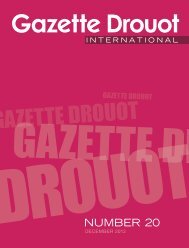Gazette Drouot - C apencheres
Gazette Drouot - C apencheres
Gazette Drouot - C apencheres
Create successful ePaper yourself
Turn your PDF publications into a flip-book with our unique Google optimized e-Paper software.
THE MAGAZINE ART & PATRIMOINE<br />
Sherlock Holmeses of art<br />
In the Musée du Louvre, visitors to the south wing<br />
stroll around completely unaware that in the basement,<br />
in laboratories barred to the general public,<br />
a number of researchers and extraordinary experts<br />
are busy investigating and tracking down the truth<br />
to determine the authenticity of objets d’art. Is the<br />
museum's Egyptian head in blue glass a fake? For<br />
eighty years, the Egyptologist community has had its<br />
doubts about the genuineness of this statue,<br />
acquired by the museum in 1923. To decide the<br />
answer once and for all, the scientists at the Centre<br />
for Research and Restoration of the Museums of<br />
France (C2RMF) have used a jewel of technology:<br />
"Aglaé", the Grand Louvre’s elementary analysis accelerator,<br />
which can precisely analyse the chemical<br />
composition of any object without having to take a<br />
sample. "It's the only particle accelerator in the world<br />
entirely dedicated to the study of heritage," says<br />
Marie Lavandier, the centre's director. The Egyptian<br />
head, which could not be subjected to the removal of<br />
even the tiniest sample, was recently analysed with<br />
Aglaé. The accelerator, with its 25-metre barrel,<br />
bombards the object with ions, thus stimulating the<br />
material, which reacts and then emits X-rays containing<br />
the object's chemical record sheet. The composition<br />
of the glass reveals traces of arsenic and lead<br />
characteristic of objects made in… the 18th century!<br />
The verdict is announced: the work is a remarkable<br />
fake. A case solved with undeniable success by these<br />
dedicated art sleuths. In Greek mythology, Aglaea<br />
(Aglaé in French), the youngest of the three Graces,<br />
symbolises radiant beauty: the perfect name for<br />
C2RMF's jewel in the crown, one of the many cutting<br />
edge tools available to the centre's experts.<br />
126 GAZETTE DROUOT INTERNATIONAL I N° 19<br />
The C2RMF, created in 1998 when the research laboratories<br />
merged with the restoration department of<br />
the museums of France, now employs a hundred and<br />
sixty people divided between two sites: the restoration<br />
workshop in the Petite Ecurie du Roi facing the<br />
Château de Versailles, and the laboratory under the<br />
Palais du Louvre. "Our team contains a highly original<br />
range of professionals from all sorts of backgrounds<br />
– chemists, photographers, physicists, radiologists,<br />
optics specialists, archivists, computer scientists,<br />
restorers, curators, art historians and archaeologists –,<br />
thus enabling a multidisciplinary approach across the<br />
board serving France's museums," says the director.<br />
At the foot of the Louvre's venerable Pavillon de Flore,<br />
the laboratory lies hidden behind two doors worthy<br />
of a safe. The five thousand square metres of this<br />
underground haunt, divided into three levels under a<br />
vast glass roof, is a veritable hive: a dark room with<br />
walls seven metres high, a library, a series of rooms<br />
with small windows for the lab assistants, a control<br />
room where five people operate the particle accelerator,<br />
and a huge door leading to the Louvre's<br />
surrounding underground passage, used for moving<br />
art works around. Each year, thousands of objects<br />
pass through the scientists' hands. Ultra-sophisticated<br />
analysis techniques – including raking light,<br />
infrared, UV and radiography – can reveal the framework<br />
of a statue, the rough patches on a painting,<br />
Designed by architects Jérôme Brunet and Éric Saunier,<br />
the 5,000 square metre laboratory is divided into three<br />
levels under the Louvre's Pavillon de Flore.




